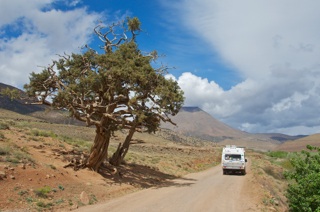
For us, the greatest strength of the Tiger is the basic floor plan, which provides more living space and a much roomier feel than any truck camper or van conversion anywhere near the Tiger's size. Virtually all of the many folks who have come into our unit (it does generate a lot of attention) comment on the amazingly roomy interior. The use of the L-shaped couch in place of the more common dinette makes for both more comfortable seating and more open floorspace, always at a premium in a small unit. At 7'3" wide, the Tiger is wider than a standard van body, but narrower than most truck campers or other RVs. Even so, it has an interior that is more open and spacious than much larger campers. Provan has been building the Tiger for many years utilizing the identical floor plan, and as a result there is not a wasted inch anywhere. Everything is very well thought out and efficient.
Here are some comparisons that factored into our decision to get the Tiger. Naturally, these comparisons are all with vehicles available in the US. There are many more choices available to european buyers, but they are not importable into the states.
Tiger vs Larger Class C such as View, Lazy Daze or Born Free: All the larger units I've seen are simply too big for off the beaten path travel on unpaved roads. They are often 8' wide (View/Navion are 7 1/2’) and over 10' tall; they have limited ground clearance and long rear overhangs, and of course none of them have four wheel drive. They can be very comfortable to travel in, but only if you're willing to stay almost entirely on paved roads.
Tiger vs Van Conversion: I've yet to be in one of these that felt big enough for full time living. We really wanted a vehicle based on the Sprinter van, but they are very small. I'm 6' and about 260 lbs; in the Tiger I feel pretty comfortable, in any van I've ever looked at I feel like I can't let my elbows stick out. There are many nice units in this class, but no factory 4x4, limited ground clearance and small size make them unattractive to us, although one of them may fit your needs perfectly.
Tiger vs Overland Adventure Vehicles (Added Spring 2011): There are more interesting vehicle choices out there now than there were in ’07. I have not done a great deal of research in this area, but will share some links you may want to explore. The Overland Adventure market seems to be growing and more vehicles are being developed as time goes on. In my mind, most of these cannot fairly be compared to a Tiger because they tend to be considerably more expensive and most of them are substantially larger and heavier as well. They may offer good value for anyone contemplating travel that will really require their more sophisticated systems and more robust build quality, but how much of that is actually necessary depends entirely on the purchaser and their own travel plans.
For what we do, which in all honesty is quite a lot, the Tiger has been perfect. I do not believe that a better all around vehicle with an equivalent combination of compact size, comfortable living space and overland capability can be found at or near the Tiger’s price. If I were planning a trip crossing Russia to Mongolia and China... well, maybe something even sturdier would be better. I don’t really know; in the end, you must simply make your own choice.
At any rate, here are a few links if you’d like to look into these vehicles:
-
•Global Expedition Vehicles; Mike and René Van Pelt in Nixa, Missouri build an array of different models on a variety of chassis. Currently, all of their models are larger than the Tiger, but they will custom build so perhaps a smaller vehicle could be had from them.
-
•Earth Roamer is a well established builder in this category. They build high quality, very capable albeit very pricey vehicles.
There are also some smaller vehicles available that are more cost competitive with a Tiger, but with some sacrifice in living space. One of these is:
-
•XP Camper is a new company building what appear to be high quality pop up campers. These units appear to combine a high build quality with compact size and feature marine grade fixtures and all diesel appliances. They are building their first production unit right now (May 2011), after several prototypes.
-
•L’Azalai is a wonderful little vehicle available only in Europe and probably impossible to import to the US. Fun to look at nonetheless.
Tiger vs Truck Camper: If we limit cost to under $100,000 for a new vehicle, this is probably the best comparison to the Tiger for off pavement use on a long term basis. They both share the starting point of a truck chassis with all that makes possible; factory four wheel drive, diesel power, greater ground clearance, more roomy cab seating area, etc. True, the Tiger is more expensive, probably by about 20%, but I feel that it has many advantages. I looked fairly hard at this combination and found that the cost of the diesel 4x4 truck was about $35k and a good quality camper almost the same, call it $30k, for a total of $65 - $70k while we paid $85k for the Tiger (these price comparisons from 2007). Given that many campers are seriously overweight if mounted on a 3/4 ton chassis, a larger truck such as an F-450 may be required and that would bring the price of the truck/camper closer to that of the Tiger. Now, of course, there are far more trucks and campers around and it is more possible to find separate deals on the truck and the camper, or to buy one or both used and save more money. Used Tigers are hard to find due to the small number built each year, although the factory will build a unit on your own truck chassis so long as it has sufficient weight capacity and it is a body style that they have molds to fit. Other than lower cost and the ability to use the truck separately from the camper, we feel that all of the advantages go with the Tiger. As full timers, the separate use of the truck was not important to us, and we felt that the cost difference was more than made up by the many advantages of the Tiger.
Some of those are:
-
1.Side entry door. The back of any rig gets very dirty; every camper owner we know complains of the dirty back door that most campers have.
-
2.Access from the cab to the living area. This is a wonderful asset of the Tiger, not only for pass through while on the road or in poor weather, but also the added openness and use of the space in the front cab while parked. The ability to get up front and drive off without having to go outside can be a real security advantage as well.
-
3.Lower center of gravity and better balance for better handling. The Tiger has a much lower overall height and cg than any camper and as a result handles very nicely. I have never had a camper, but just watching some of them go down the road and lean around turns can be scary. The weight distribution on the Tiger is also excellent as it has much less rear overhang than most campers.
-
4.Interior space. As discussed above, campers tend to feel narrow because the entire lower part of the vehicle has to fit within the narrowest space between the wheels. This also forces components such as propane and holding tanks higher in the rig as opposed to the below floor location of the Tiger. We feel that the Tiger is much more comfortable inside than any camper floor plan we've seen.
-
5.No need for dual wheels. You can get a Tiger with duals, but there is generally no need to do so. Dual wheels off road can be a problem because they tend to pick up rocks between the tires that then must be removed lest they damage the tires. Duals also cost more on toll roads and bridges and in some countries can even limit the traffic lanes you are allowed to drive in. We did not want duals.
-
6.Better quality than a small camper. I could be mistaken here, but from what looking I've done, it is difficult to find a really good quality small camper. As with most of the RV industry, bigger is thought to be better and the "upscale" higher quality campers all tend to be bigger as well.
-
7.Smaller size. In order to get a toilet/shower included, a camper must extend beyond the rear of the truck bed. Along with the tendency for manufacturers to equate better quality with larger units, most folks end up buying really large, heavy campers and then being unhappy with the overall size, weight and handling of their rig. While a camper approximately the same size and weight as the Tiger is theoretically possible, almost everyone ends up buying a bigger unit, which then requires a bigger truck.
-
8.What do I wish the Tiger had or what compromises do we make? I wish the Tiger had dual pane windows and better insulation. In cold weather we naturally keep the interior warm and thus get lots of moisture condensation on the inside of the windows. This is true of all RVs with single pane windows used in cold climates, but some of the better campers can be had with dual panes and better insulation. Also, the Tiger is smaller than we would like in two areas, both of which are typically larger in campers: the bed in the Tiger is small at 53" x 80". It works for us, but other couples might see this as a problem. And, the refrigerator is an under counter unit of around three cubic feet while most campers have six cu ft units. We manage to live full time with the small fridge, but again it might be seen as a problem for some. That's about it though.
Conclusion: The combination of small size with off road capability is very hard to come by, with few manufacturers offering vehicles that fit this description. The Overland Adventure market offers some very capable and attractive vehicles, but at a premium price and most often in vehicles that are considerably larger and heavier than the Tiger. Even in Europe, where smaller motorhomes are the norm, very few units provide off road capability. European travelers seeking this combination basically must choose between very small units based on Land Rover or Toyota Land Cruiser chassis, or very large units based on Mercedes or similar truck chassis. In my mind, the Tiger occupies a unique spot in the marketplace, offering a terrific combination of size, capability and affordability. It is admittedly not perfect, but what vehicle is?
For a very interesting perspective on this discussion, go to Rob & Nina Blackwell’s White Acorn site. After touring the Americas in their Tiger, they bought a used Earth Roamer and Rob offers some interesting comparisons between the two vehicles.
You can learn the latest information about the Tiger by going to the Provan website at www.tigermotorhomes.com.






